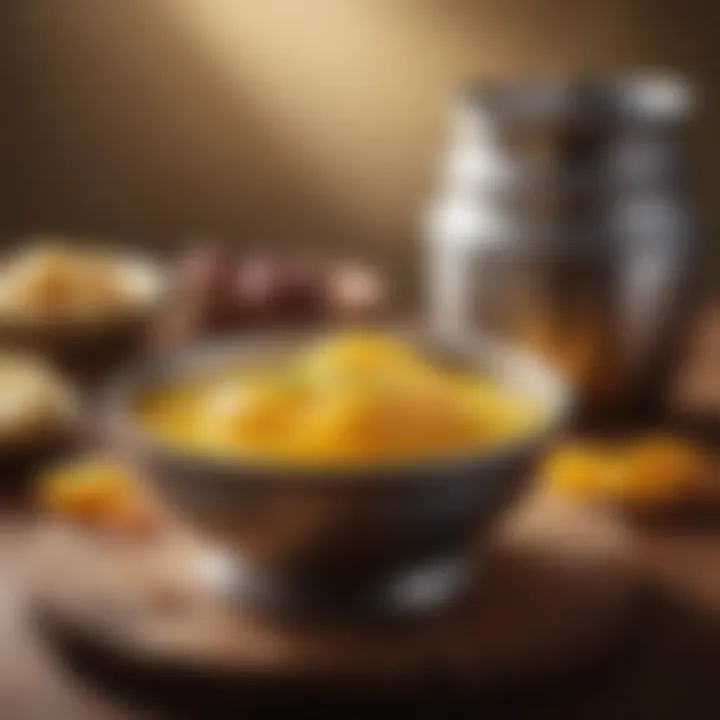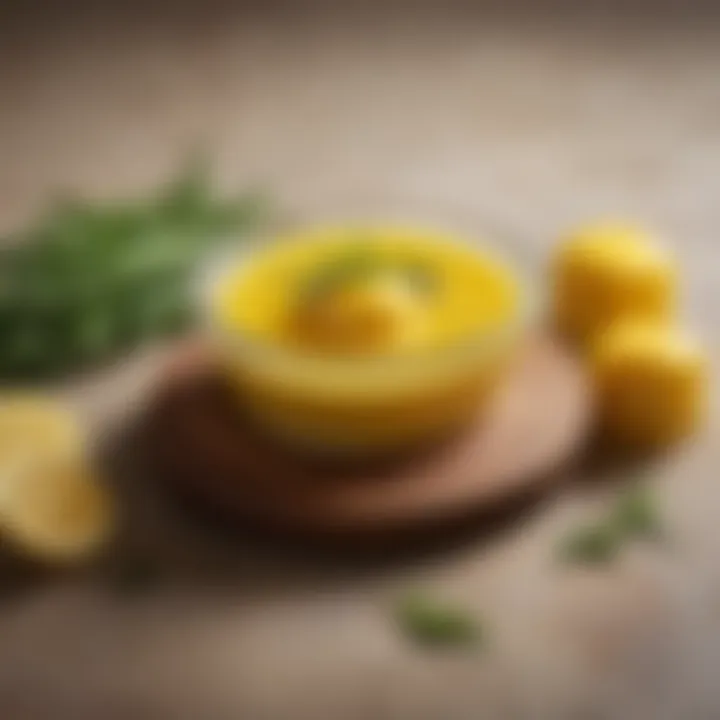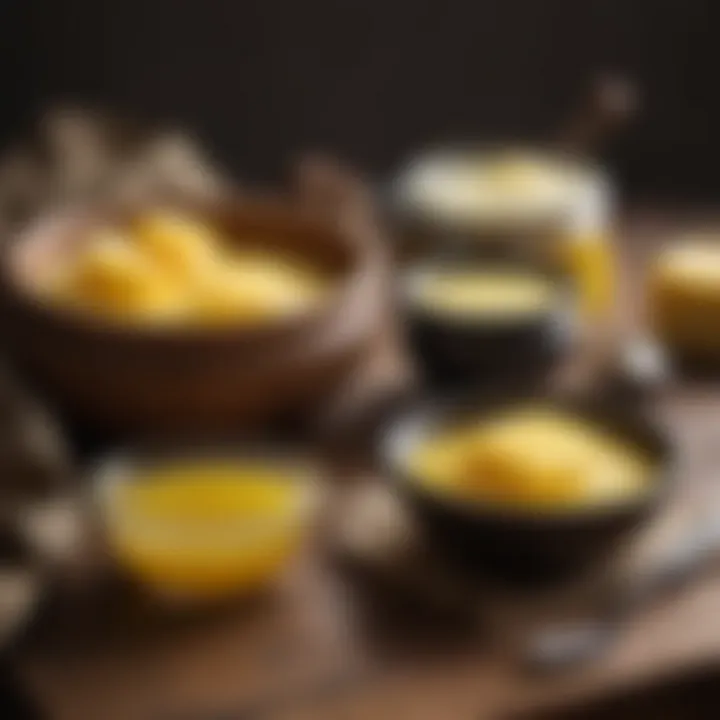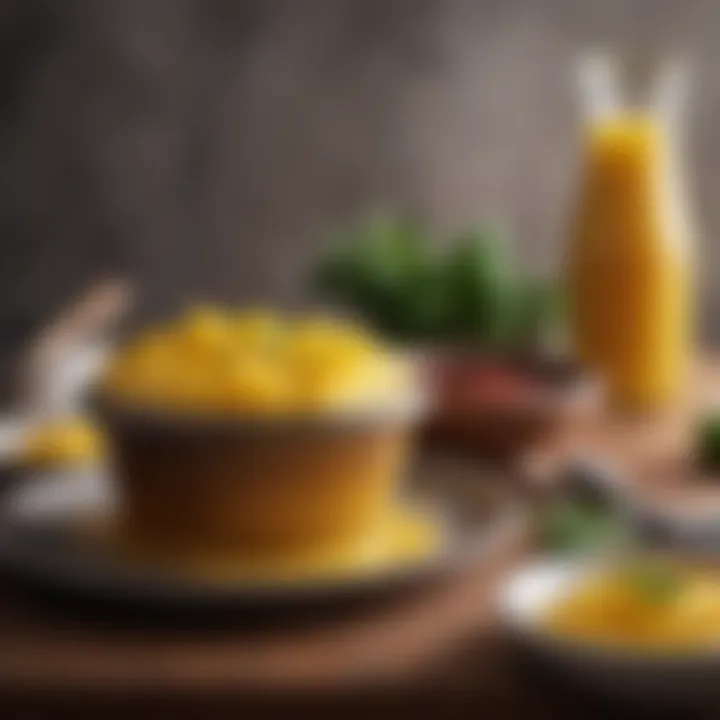Ghee and Clarified Butter: Understanding Culinary Treasures


Intro
Ghee and clarified butter represent two distinguished forms of cooking fats that not only enrich dishes but also carry significant history and cultural value. This section provides a concise overview of what drives the culinary interest in these ingredients. The texture, flavor, and nutritional aspects make ghee and clarified butter integral to kitchens around the world.
Beyond their usefulness in cooking, both ghee and clarified butter showcase fascinating origins across various cuisines. Ghee, widely used in Indian cooking, contains a rich tradition where it steps beyond just a cooking fat, into a realm of health and spirituality. Clarified butter, associated with French culinary techniques, highlights a sophisticated approach to preparing meals. Engaging further in their unique features uncovers recipes, health benefits, and practical realities that allure contemporary cooks seeking quality and efficiency.
This article not only discusses definitions and historical anecdotes but also delves into practical and nutritional facets. An exploration into how these cooking mediums adapt to modern gastronomy might shed light on their continued popularity as busy individuals navigate daily meal preparation.
Understanding Ghee and Clarified Butter
Cooking fat forms a crucial element in culinary practices across the globe. Among the prominent types is ghee and clarified butter, inherently distinct but both pilhars in modern kitchens. This section aims to assist culinary enthusiasts in recognizing the importance of these two components. Each has unique characteristics, uses, and nutritional values that make them worthy alternatives to traditional cooking oils.
Defining Ghee
Ghee can be defined as a type of clarified butter that has been cooked further to remove all moisture, resulting in a rich, nutty flavor. Its origins lie primarily in Indian cuisine but have spread globally due to its versatility and health benefits. Ghee is lactose-free, making it suitable for individuals with lactose intolerance. Its high smoking point means it can withstand many cooking temperatures without breaking down. This property enables it to be used in frying, sautéing, and even baking. In addition, ghee contains butyric acid, which is thought to support digestive health and enhance nutrient absorption in the body. Notably, ghee also boasts a range of vitamins such as A, E, and K.
Understanding Clarified Butter
Clarified butter, often referred to simply as melted butter, is the result of separating the milk solids and water from the liquid fat. It serves as a valuable cooking fat in various cuisines, especially French cooking. The clarification process enhances its stability and allows it a higher tolerance to heat compared to regular butter. Therefore, clarified butter is favored for sauces, such as hollandaise, and various cooking methods where pure butter would burn. It retains some flavor of butter but eliminates much of the moisture and impurities. Those seeking a cleanse from dairy without entirely avoiding the taste of butter may find clarified butter a practical choice. Furthermore, it is easy to prepare at home, making it accessible for those interested in food preparation.
It is important to highlight that while ghee and clarified butter may seem interchangeable, their methods of preparation and origins lead to distinct flavors and benefits, enriching a cook's repertoire.
Historical Context
The history of ghee and clarified butter is rich and nuanced, revealing their significant roles in culinary traditions across various cultures. Understanding this context enhances appreciation and application of these cooking fats today.
Origins of Ghee
Ghee, often viewed as a cornerstone of Indian cuisine, has roots dating back thousands of years. It is mentioned in ancient texts like the Vedas, signifying its importance in rituals and offerings. The process of making ghee, originating in the Indian subcontinent, involves slow cooking butter to separate the water and milk solids, resulting in a pure fat that withstands high temperatures better than regular butter. This exceptionality extends its lifespan and flavor, making it a staple in traditional dishes and festivities.
The cultivation of ghee has evolved into a skilled art. Households regard it as a sacred ingredient, deeply intertwined with Ayurveda, which praises ghee for its health benefits. Its historical significance continues to influence modern dietary preferences.
Evolution of Clarified Butter
Clarified butter has a different yet equally compelling lineage, often associated with cuisines across the globe beyond the Indian context. It has prospered since the Medieval era in Europe. Documents from that time indicate cooks leveraged clarified butter for frying and baking, as it retains flavor while resisting burning. The method of clarification serves to enhance shelf stability, making it suitable for long voyages as it does not spoil easily.
Traditionally, chefs used this cooking fat in French kitchens, leading to its integration into classical cooking techniques. Known in French as "beurre clarifié," clarified butter became a chef’s ally for its versatility. Its relevance has persisted and expanded, adapting with time into modern recipes and dining concepts, showing the ongoing connection between history, creativity, and culinary practice.
The journey of ghee and clarified butter reflects adaptation and enrichment through centuries, illustrating their esteemed status in global cuisine.
Hyperlinking resources enhance credibility. You might refer to Wikipedia for further details on ghee or dive into Britannica for a comprehensive overview of clarified butter’s history.
Nutritional Composition
Understanding the nutritional composition of ghee and clarified butter is crucial for any cook or food lover. These fats are not just cooking mediums; they also contribute essential nutrients to our meals. We will delve into their calories, fat content, vitamins, nutrients, and overall health benefits.
Calories and Fat Content
Ghee and clarified butter are relatively high in calories, primarily because they are fat-based. Ghee contains approximately 112 calories per tablespoon, while clarified butter might be similar or slightly varied based on the brand and preparation method. Most of their calorie content comes from fat, which is predominantly saturated fat. Some individuals have concerns over saturated fat, yet recent studies show that, consumed in moderation, these fats can be part of a balanced diet.
Moreover, ghee offers more short-chain fatty acids which can benefit energy metabolism. These constituents stand in contrast to trans fats found in many processed foods, affirming ghee and clarified butter's status as a superior choice. Being mindful of portion sizes allows enjoyment of their flavor while retaining health goals in focus.
Vitamins and Nutrients
In terms of nutritional value, both ghee and clarified butter stand out with their vitamin profiles. They are good sources of fat-soluble vitamins A, D, E, and K, which play significant roles in maintaining bodily functions. For instance:
- Vitamin A is vital for maintaining good vision and supporting immune function.
- Vitamin D helps with calcium absorption and bone health.
- Vitamin E is known for its antioxidant properties which protect cells from damage.
- Vitamin K is crucial for blood clotting and bone metabolism.


In addition to these vitamins, these fats may contain some conjugated linoleic acid (CLA), which has been studied for its potential health benefits, including metabolic health.
Health Benefits
The health benefits associated with ghee and clarified butter are wide-ranging. They are lactose-free, making them suitable for individuals with lactose intolerance. This aspect distinguishes them from regular butter, allowing more inclusion in various diets.
Moreover, due to their high smoking point, these fats can be an excellent option for cooking at high temperatures. When comparing ghee to vegetable oils, it yields better flavor and stability once heated. Including these fats in moderation can promote satiety, potentially aiding in weight management.
However, individuals must consider their overall dietary context. Given their calorie density, integrating ghee or clarified butter efficiently into cooking or at the table applies mindfulness and a strategic approach.
In summary, incorporating ghee and clarified butter into meals not only enhances flavor but provides critical nutrients beneficial for overall health.
Culinary Applications
Culinary applications of ghee and clarified butter are fundamental when considering their growing appeal in contemporary cuisine. These cooking fats add not only a significant flavor but also unique cooking attributes that enhance various culinary techniques. The rising interest in healthier cooking mediums has reinforced the necessity to understand these applications fully.
Cooking Techniques with Ghee
Ghee is known for its high smoke point, which is around 450°F (232°C). This makes ghee special for various high-heat cooking methods, like frying and sautéing. It remains stable under heat when compared to some other oils, reducing the risk of harmful compounds forming.
Some common cooking techniques with ghee include:
- Sautéing: Ghee effectively caramelizes onions and browns spices, creating an aromatic base for many dishes.
- Braising: Its rich flavor infuses into meats and vegetables, tenderizing them while adding depth to the overall dish.
- Baking: Use ghee in place of butter or oil to slightly alter the flavor and improve moisture content in baked goods.
When raising dishes' aroma, consider adding ghee before serving to experience its maximum flavor potential.
Using Clarified Butter in Recipes
Clarified butter distinguishes itself with its unique flavor and versatility in the kitchen. It is milk solids and water content free, mainly comprised of fat, enhancing its cooking attributes. Many chefs find clarified butter vital for complex recipes.
Clarified butter works well for:
- Sauces: Famous sauces like hollandaise or beurre blanc greatly benefit from clarified butter for a creamy texture.
- Finishing Touch: Drizzling clarified butter over cooked vegetables or seafood enriches dishes with a velvety finish.
- Baking Substitute: It can replace oil or traditional butter in recipes. This change often makes the final product crisper and adds flavor complexity.
The stability of clarified butter in storage allows for effective use without immediate spoilage and enhances both flavor profiles and preservation qualities.
Comparison of Cooking Performance
When assessing cooking performance, ghee and clarified butter exhibit substantial advantages. While both contribute flavor, their capabilities allow for diverse uses across varying cooking techniques.
A useful comparison can be illustrated in the following ways:
- Smoke Point: Ghee's higher smoke point makes it better suited for frying. Clarified butter, while having a good smoke point, finds its strengths in controlled cooking like sauces.
- Flavor Impact: Ghee provides a deeper, nuttier flavor due to the initial browning of milk solids. In contrast, clarified butter has a mild profile, suitable for recipes where the fat should not overshadow other ingredients.
- Storage and Usability: Ghee can be stored at room temperature without losing potency. Clarified butter typically requires refrigeration for optimal freshness.
These aspects showcase how ghee and clarified butter serve not just culinary roles, but also play vital parts in balancing flavors, ensuring dish cohesion, and catering to a myriad of cooking styles. By understanding these nuances, cooks can enhance their culinary repertoire and create better dining experiences.
The key takeaway is that both ghee and clarified butter, with their distinctive traits, expand the culinary possibilities and empower cooks looking for a flavorful journey.
Visit Wikipedia for further details.
Cultural Significance
Cooking fats like ghee and clarified butter carry significant cultural weight far beyond their culinary applications. They are intertwined with traditions, beliefs, and historical practices. Understanding their roles offers insight into diverse culinary worlds. Ghee represents nourishment in many South Asian cultures, symbolizing health and abundance. In contrast, clarified butter reflects essential techniques in Western food preparation, influencing flavors and textures.
Ghee in Traditional Cuisine
Ghee holds a revered place in Indian and South Asian culinary practices. This ingredient is often associated with ritual, tradition, and Ayurveda, the ancient Indian system of medicine. In many households, ghee is not only used for cooking but also has sacred significance. Its rich flavor enhances classical dishes such as dal, khichdi, and various sweets. Moreover, ghee is placed in religious offerings as a mark of purity and devotion.


- Quality: Ghee is made from the milk of healthy cows, regarded as sacred in several traditions. This aligns with the notion that the cooking fat must possess the best qualities for health and favor.
- Cooking Style: The high smoke point of ghee makes it suitable for various cooking techniques, including sautéing and frying, which are fundamental to traditional recipes.
- Cultural Rituals: Special occasions such as festivals see an uptick in ghee usage, amplifying its connection with joy and celebration.
In addition to its culinary applications, there are health claims surrounding ghee based on traditional wisdom, promoting digestive benefits and overall wellness.
Clarified Butter in Western Cooking
Hailing originally from French culinary practices, clarified butter has become a staple in modern Western cuisines as well. This cooking fat has distinct characteristics that chefs and home cooks appreciate. It presents notable aroma and flavor possibilities for a myriad of dishes, especially in French sauces such as * beurre blanc* or sauce hollandaise.
- Versatility: Used in various methods of preparation, clarified butter is essential for making perfect sautéed dishes, baked goods, and even for greasing pans without imparting unwanted flavors.
- Quality Control: The clarification process removes milk solids and water, allowing for more extended storage without souring. This quality makes it desirable for busy cooks seeking both functionality and flavor in their cooking fats.
- Contemporary Influence: As culinary trends shift towards clean eating and refined flavors, clarified butter rises in popularity as a clean, effective alternative to standard cooking oils or margarine.
Clarified butter's sublime richness and profound culinary value resonate strongly within Western gastronomy, making it indispensable in contemporary cooking.
Through both ghee and clarified butter, we see how culturally significant cooking fats enhance not only flavors but also connect individuals to their heritage, practices, and communal identity.
Making Ghee and Clarified Butter at Home
Homemade ghee and clarified butter provide more than just flavor; they offer a connection to culinary tradition and a certain control over the quality and ingredients used. Making these cooking fats at home is important. It lets cooks avoid additives and preservatives often found in commercial options. Additionally, it is an economical way to ensure access to high-quality fats. The unique flavors of homemade variations can often enhance dishes more than store-bought choices.
Step-by-Step Guide to Preparing Ghee
Ingredients
- Unsalted butter (preferably organic, grass-fed)
Equipment
- A heavy-bottom saucepan
- A fine-mesh sieve or cheesecloth
- A heat-proof jar for storage
Instructions
- Melt the Butter: Start by placing the unsalted butter into a heavy-bottom saucepan. Heat over medium flame until melted. Ensure to keep an eye on it to prevent any burning.
- Simmer: Once melted, reduce heat to low. Allow the butter to simmer. As it simmers, white foamy milk solids will form on the surface.
- Skimming: After about 10-15 minutes, skim off the foam using a spoon. This helps purify the ghee.
- Clarification: Continue to simmer. You will hear a crackling sound. This indicates that water is evaporating and the milk solids are beginning to sink.
- Color Change: When the liquid starts turning a golden color and a nutty aroma emerges, it's nearly done. Keep simmering until the bottom of the pan becomes slightly golden, taking care not to let it burn.
- Strain: Once ready, remove from heat. Allow to cool slightly, then pour through a fine-mesh sieve or cheesecloth into a heat-proof jar, discarding the milk solids.
- Storage: Allow it to cool completely before sealing the jar and storing it in a cool, dark place.
Simple Process for Clarified Butter
Ingredients
- Unsalted butter (any variety is fine)
Equipment
- A saucepan with a heavy bottom
- A fine-mesh strainer or a coffee filter
- A storage container
Instructions
- Melt the Butter: Take the unsalted butter and place it in a saucepan. Gently melt it over low heat. No need to rush.
- Separation: As butter melts, it will naturally separate into three layers. The foamy white layer sits on the top, the clarified butter is in the middle, and milky solids settle at the bottom.
- Remove Foam: Carefully spoon off the foam from the top layer. This process ensures purity.
- Pour and Strain: Slowly pour the clear yellow layer into a container, ensuring not to disturb the milky solids at the bottom. You can strain it through a fine-mesh strainer or filter for extra clarity.
- Storage: Store the clarified butter in a sealed container in the refrigerator for good preservation.
Making ghee and clarified butter at home allows full control over the final product, giving qualities and flavors not always present in store-bought versions.
By preparing these fats from scratch, cooks reconnect with the essence of traditional culinary practices, elevating their dishes with quality and personalized flavors.
Storage and Shelf Life
Understanding the storage and shelf life of ghee and clarified butter is crucial for both preserving their unique flavors and extending their usability. With the right storage techniques, these fats can maintain their quality for an extended period. This importance not only concerns safety from spoilage but also affects the taste and nutritional potency. Given the growing popularity of these ingredients in culinary practices, knowing how to store them properly can significantly impact the passion of food lovers and professionals alike.
Storing Ghee Properly
Ghee, often viewed as a delicacy, requires careful storage to keep its rich taste intact. It can be stored either in a sealed container at room temperature or refrigerated, depending on individual preferences.


- Room Temperature Storage:
- Refrigeration:
- Ideally, you can store ghee in a glass or ceramic jar. This helps inhibit moisture in, which can accelerate spoiling. Make sure the lid is tight to keep it airtight.
- Ghee can last previously to indoor conditions; generally, it retains good quality for several months within the paramenter of a tightly sealed dish.
- Placing ghee in a refrigerator can extend its shelf life considerably, sometimes up to a year. With this step, the texture may become firmer but it will still urge its distinctive aromas and flavors.
- Always store ghee away from strong-smelling foods as absorption of odors can occur.
Overall, pay attention to the taste and smells. If it develops an off flavor or scent, it is best to dispose of it.
Maintaining Clarified Butter Freshness
Clarified butter tends to be more shelf-stable than regular butter due to its lack of water and milk solids. Just like ghee, maintaining the freshness of clarified butter requires practical solutions.
- Cool and Dark Environment:
- Refrigeration Tips:
- Store clarified butter in a cool, dark place. If you prefer leaving it out, umbrella utmost attention to temperature fluctuations which may affect quality.
- Some choices include a sturdy European butter dish or a glass jam jar to create a wholesome experience for representation.
- For enhanced longevity, especially if you don’t use it often, keep clarified butter in the refrigerator. Clear containers are sensible here too since different models do present a visual allure to kitchens or cabinets.
- Use a sterilized spoon each time you conduct, as introducing moisture will ruin the overall performance over time.
Common Misconceptions
Understanding ghee and clarified butter requires addressing common misconceptions that surround these cooking fats. This section highlights the vital need for clarity around these two culinary staples, as many people often confuse their usage and benefits.
Ghee and clarified butter are not merely varied versions of the same fat; they possess distinct properties and implications for cooking and health.
Clarifying the Differences
One misconception is that ghee and clarified butter is interchangeable. While they share similarities in preparation, the differentiation lies primarily in the process and the resulting flavors. Ghee undergoes a longer cooking process, which allows milk solids to caramelize and impart a nutty flavor. In comparison, clarified butter is simply melted butter from which the milk solids are removed, resulting in a much milder taste.
This distinction influences how these fats behave in cooking. Ghee features a higher smoke point compared to clarified butter. Discerning cooks often favor ghee for high-heat methods such as frying, while clarified butter may be more suitable for light sautéing or as a base for sauces. Recognizing these differences leads to better and more flavorful cooking experiences.
Debunking Nutritional Myths
Another pervasive myth involves the health implications of ghee and clarified butter. Some believe that both contain high levels of saturated fats and thus pose similar health risks as margarine or other hydrogenated fats. However, research suggests a more nuanced view. For instance, ghee is rich inbutyrate, a beneficial fatty acid known to support gut health. Furthermore, because ghee is lactose-free, it can be an acceptable option for those with dairy intolerance.
Some cooking enthusiasts may also think that using fats like ghee equals a lack of nutritional value. In reality, both ghee and clarified butter can provide vitamins A, D, E, and K, crucial for health. Understanding the nutritional profiles helps mitigate unwarranted fears and provides a mandate for thoughtful inclusion in balanced diets.
“Ghee and clarified butter, when used mindfully, can enhance the flavors in our meals while supporting health.
Current Trends
The culinary landscape continues to evolve. In recent years, ghee has seen a remarkable resurgence in popularity. As people become more health-conscious, they seek out alternatives that offer both flavor and nutritional benefits. Ghee, with its unique preparation method and rich nutritional profile, fits this demand perfectly. This section explores the rising interest in ghee and how clarified butter has found its niche in modern gastronomy.
Rising Popularity of Ghee
Ghee's journey to popularity ties closely to increased awareness of dietary choices. It is no longer viewed merely as a traditional ingredient used in Middle Eastern and South Asian cuisines. Ghee has made its way into many households as a versatile cooking fat.
There are several reasons contributing to ghee's rise in popularity:
- Nutritional Awareness: Many individuals today turn to ghee for its rich content of unsaturated fats. Ghee contains essential fatty acids, promoting cardiovascular health.
- Digestive Benefits: Ghee is known to be a good source of butyrate. This fatty acid is associated with numerous digestive benefits, including anti-inflammatory properties and improved gut health.
- Culinary Versatility: Cooking enthusiasts appreciate ghee for its high smoke point, making it ideal for frying and sautéing. Its nutty flavor adds complexity to dishes, inspiring chefs and home cooks alike.
- Cultural Heritage and Authenticity: There is growing interest in foods that honor cultural heritages. Ghee fits perfectly into this trend, satisfying cravings for authenticity while presenting cuisines from around the globe in a new light.
Ghee's untapped potential continues to attract various demographics. Health bloggers and social media influencers encourage testing this cooking fat, leading to its embrace in many modern kitchens.
Clarified Butter in Modern Gastronomy
Clarified butter has also carved out a space in contemporary cooking. Modern chefs recognize its importance in developing recipes that require precise flavor management without burning. This choice enhances meals without overpowering other ingredients with unwanted dairy flavors.
There are distinct benefits linked to the integration of clarified butter in today's culinary practices:
- Pure Flavor Profile: Clarified butter boasts a subtle and concentrated flavor, allowing chefs to construct dishes in layers without distraction.
- Health Aspects: For those lactose intolerant or allergic to casein, clarified butter offers a dairy-free alternative while retaining beneficial fats. Its lactose content is almost non-existent.
- Emphasis on Technique: The preparation process itself involves skill and attention. This elevation of clarified butter resonates with chefs aiming to refine their techniques and artistry in the kitchen.
- Increasing Availability: As culinary schools incorporate traditional cooking methods into their curriculums, there is the larger drive for resourcing high-quality clarified butter products, fueling home cooks’ experimentsf.
Ghee and clarified butter serve as prime examples of how historical culinary practices remain relevant and adaptable. The growing interest in these cooking fats is a reflection of both dietary trends and authentic flavor profiles. Amid today's fast-paced lifestyle, both ghee and clarified butter stand out as reliable options for anyone looking to enhance their cooking.
The uniqueness of ghee and clarified butter illustrates their ability to bridge traditional cuisines with modern requirements, proving their place in today’s gastronomy.







